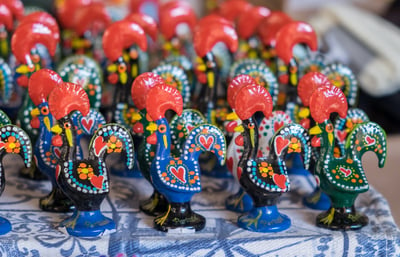O Galo de BarcelosThe Rooster of Barcelos can be seen pretty much all over Portugal, especially in those cute little souvenir shops.
Usually the galo comes in ceramic form, but you will also see it embroidered on towels and aprons, in woodwork, and even on key-chains!

The most common version of the Galo de Barcelos is black with colourful dots and red hearts, with a red comb, on top of a blue base. Over the years, of course, different artists have added their own unique touches and variations to the design. Most are adorned with vibrant colours and patterns typical of Portuguese handicrafts.
Many Portuguese people keep galos in their households because they are supposed to bring good luck. But why is this rooster considered such an important symbol of Portuguese culture?
It all started with a lendathe legend, folktale of the galo that has been passed down from generation to generation. Even though there are many different versions to the story, the ending is always the same. There is a saying in Portugal that goes A cada conto se acrescenta um pontoEach story adds a detail , which means that every time a tale is told, another piece of information is added. (I guess we can say the same for gossip!)
The Legend of The Galo de Barcelos
Legend has it, that in the 16th century, a serious crime was committed in the city of Barcelos, which is in the Minho province in the North of Portugal. The townspeople had been searching for o culpadothe culprit , to no avail. Around the same time, a Galician man was passing through the city, on a pilgrimage to Santiago de Compostela. Because nobody recognized this outsider, they unjustly assumed it must be he who committed the crime! Despite his protests, the man was arrested and sentenced to be hanged.
The pilgrim continued to plead his inocênciainnocence , but nobody believed him. As a final attempt to avoid his terrible fate, he asked to see o juizthe judge who had passed his sentence. He was taken to the home of the judge, who happened to be in the middle of a great dinner banquet. Yet again, the pilgrim pled innocence, but of course, nobody believed him.
The pilgrim then pointed to o galo assadothe roasted rooster on the table and exclaimed:

“As certain as I am innocent, that rooster will sing when they hang me!”
Needless to say, he was laughed at and dragged out of the room.
On the day of the pilgrim’s punishment, the impossible happened. Just as he was about to be hanged, the rooster came to life, stood up, and crowed loudly. The judge ran to the gallows and was relieved to see the Galician was still alive, thanks to a loosely tied knot in the rope. He was immediately released and set free.
The Symbol of the Galo Today
Today, the galo has become an unofficial national símbolosymbol , representing honesty, trust, integrity, justice, and good fortune. The Galo de Barcelos represented Portugal in Geneva for the Portuguese Popular Art Exhibition in 1935 and continued to appear in art exhibitions and promotional materials for Portuguese tourism. Over time, it became recognized internationally as an icon of Portugal.
Next time you visit Portugal, now you’ll know the story behind those little roosters you see everywhere!





